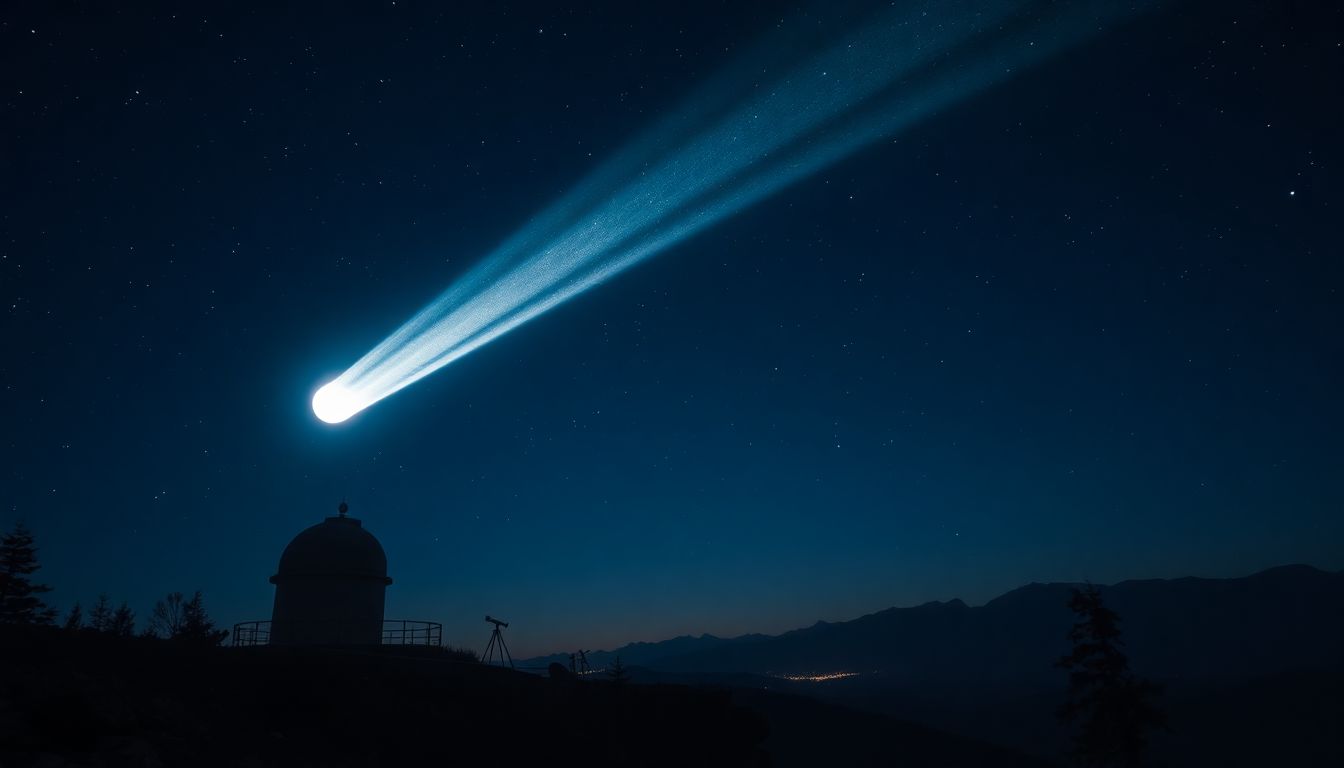
Which Comet Is Bright Tonight and What’s Its Name: Your Guide to Tonight’s Spectacular Skywatching Event
Introduction
There’s something magical about catching a glimpse of a comet streaking across the night sky. These celestial visitors are rare and beautiful, making each sighting special. If you’ve ever wondered which comet is shining brightest tonight, you’re in the right spot. Knowing what to look for turns an ordinary night into an unforgettable skywatching adventure. Let’s explore how to spot tonight’s brightest comet, what’s making it shine so bright, and how you can enjoy this cosmic show.
What Determines a Comet’s Brightness and Visibility
Factors Influencing Comet Brightness
Several things decide how bright a comet appears. First, its distance from Earth and the Sun plays a big role. The closer it is, the brighter it seems. Then, the size of the comet’s core, or nucleus, affects how much light it reflects. A larger, more active nucleus produces a more dazzling glow. Lastly, the amount of dust and gas in its coma and tail can boost its brightness, making it easier to see with the naked eye.
How Brightness Is Measured
Astronomers measure a comet’s brightness using the apparent magnitude scale. A lower number means a brighter object. For example, a comet with an apparent magnitude of 1 is quite bright, easily visible in the dark sky. Comets that reach magnitude 6 are usually the faintest visible without help, but brighter comets can shine as brightly as the stars we see every night.
When Is a Comet Considered Bright?
In astronomy, a comet is called “bright” if it can be seen with the naked eye and stands out clearly in the sky. Some famous comets, like Hale-Bopp or NEOWISE, reached brightness levels that made them visible even from cityscapes full of light pollution. When a comet’s magnitude drops below 3, it’s generally a good target for skywatchers.
The Bright Comet You Can See Tonight: Name and Details
Current Bright Comet of the Night
Right now, the spotlight falls on Comet C/2023 A1 (Lunarus). Discovered early last year, this comet has surprised many by shining brighter than initially predicted. Its previous appearances in 2000 and in recent months have kept sky enthusiasts eager for another look. Unlike some comets that fade fast, Lunarus remains a captivating sight right now in the late evening.
Predicted Brightness and Visibility
This comet’s brightness is expected to hover around magnitude 4 to 5. That makes it visible to the naked eye in dark areas and perfect for binoculars. It will be most prominent just after sunset and just before dawn. The best time to view Lunarus is between 9 PM and 4 AM, when it’s high in the sky. Its location will be near the constellation Orion, making it easier to find.
How to Find the Comet in the Night Sky
Start by locating Orion, which is easy because of its bright belt of three stars. From there, look towards the southeast or southwest depending on your location. Use a star chart or a stargazing app to get precise directions. Binoculars will show more detail, revealing the fuzzy nucleus and faint tail. For a clear view, choose a spot away from city lights and get comfortable under a dark sky.
Recent and Upcoming Bright Comets: A Skywatcher’s Timeline
Notable Comets in the Past Few Years
Recent bright comets like NEOWISE (C/2020 F3) wowed millions in 2020, making headlines worldwide. Fans also marveled at Comet Lovejoy in 2011, which was visible even in some city skies. These comets gave us unforgettable photos and memories, sparking new interest in night sky watching.
Upcoming Bright Comets to Watch
Looking ahead, astronomers predict Comet 2024 P1 (Swift-Tuttle) could become bright enough for a breathtaking sky show. It’s expected to be visible in late summer and early fall. Keep an eye on space news and astronomy updates to catch these future celestial visitors.
Why Comet Brightness Varies Over Time
A comet’s brightness depends heavily on its orbit and how close it gets to the Sun. Solar activity, like solar winds, can also influence how much dust and gas is released, affecting brightness. Sometimes, comets brighten unexpectedly, keeping skywatchers on their toes.
Expert Advice: How to Maximize Your Comet Viewing Experience
Best Equipment for Observing Comets
While you can see some comets with just your eyes, binoculars or a small telescope reveal more. If you want sharper images and detailed views, a telescope with a low-power lens works great. Smartphone apps can help track the exact position and movement of comets, saving you time.
Ideal Conditions for Viewing
The best nights for comet watching are around new moon when the sky is darker. Clear, stable skies free from clouds or city lights provide the best views. Plan your outing during the early evening or pre-dawn hours for optimal chances.
Safety Tips and Ethical Observing
Always respect private property and local regulations. Avoid using bright lights that can ruin your night vision, and don’t disturb wildlife. Remember, keeping the environment clean ensures future generations can enjoy the night sky as well.
Conclusion
Tonight, the most brilliant comet in the sky is Comet Lunarus, shining brightly for us to admire. It’s a rare treat that reminds us how wonderful our universe truly is. Grab your glasses or binoculars, find a dark spot, and enjoy this cosmic spectacle. Stay curious and keep an eye out for upcoming celestial events. The sky’s wonders are waiting—don’t miss your chance to witness them firsthand.

